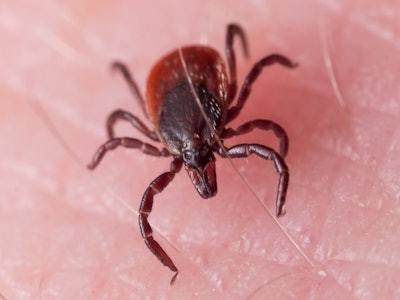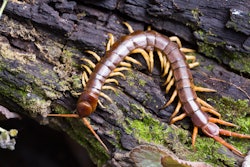
As the temperatures warm, adult deer ticks that are known for carrying Lyme disease become active as well. By May, tick nymphs emerge, which is why May is Lyme Disease Awareness Month.
With your crews starting to head out to properties to conduct spring cleanups and site visits, it’s important to be on the lookout for these troublesome ticks and be aware of the diseases certain species carry.
“Outdoor workers are at risk of exposure to tick-borne diseases if they work at sites with ticks,” the Centers for Disease Control and Prevention says. “Worksites with woods, bushes, high grass or leaf litter are likely to have more ticks. Outdoor workers in most regions of the United States should be extra careful to protect themselves in the spring, summer and fall when ticks are most active. Ticks may be active all year in some regions with warmer weather.”
Below is a handful of the most common ticks, the regions in which they are found and some of the diseases they are known to carry.
Types of ticks
Blacklegged tick (Ixodes scapularis) – Also known as the deer tick, this species is best known as the carrier of Lyme disease. Adults can be brown, red or black with a range throughout the eastern United States. The symptoms of Lyme disease vary depending on the stage of infection but include fever, rash, facial paralysis and arthritis.
This species can also transmit anaplasmosis, babesiosis and Powassan virus. Early signs of anaplasmosis and babesiosis are flu-like symptoms of fever, muscle aches and nausea, but if not treated and there are other medical conditions present, death is possible.
Powassan virus is considered rare and many who are infected do not develop symptoms. However, the virus can infect the central nervous system and cause permanent neurological symptoms. Ten percent of Powassan virus encephalitis cases are fatal.
Western blacklegged tick (Ixodes pacificus) – Found on the western coast of North America, this tick can also spread Lyme disease and anaplasmosis. Females have a reddish abdomen and black dorsal plate while males have a brownish-black color. The males do not expand in size when feeding.
Rocky Mountain wood tick (Dermacentor andersoni) – Present in Rocky Mountain states, this tick looks similar to the American dog tick but is built with a rounded, thicker body. It transmits Colorado tick fever, Rocky Mountain spotted fever and tularemia.
Colorado tick fever typically results in fever, chills and body aches. Occasionally, victims experience a biphasic fever, meaning the fever lasts for a few days, goes away and then returns for the second period of fever and illness. Weakness may last several weeks.
Rocky Mountain spotted fever (RMSF) causes people to develop a fever, headache and rash. RMSF can be deadly if not treated early with the right antibiotic. Tularemia symptoms vary depending on how the bacteria entered the body. It can be life-threatening, but most infections can be treated with antibiotics.
Lone star tick (Amblyomma americanum) – Widely spread through the eastern U.S., this tick is more commonly found in the South. It is a very aggressive tick that bites humans. The adult female has a very noticeable white dot on the center of her back.
It can spread ehrlichiosis, Heartland virus, Southern tick-associated rash illness (STARI) and tularemia. Early signs of ehrilciosis include severe headache, fever, muscle aches, nausea, confusion and rash. If not treated, it can sometimes cause severe illness that may result in death.
Victims of Heartland virus experience fever, fatigue, decreased appetite, headache, nausea, diarrhea and muscle or joint pain. Almost all patients with Heartland virus are hospitalized.
STARI is a rash that may include fever, headache and fatigue. It resembles early Lyme disease and can be treated with doxycycline.
American dog tick (Dermacentor variabilis) – This tick can be found east of the Rocky Mountains and in certain areas along the Pacific Coast. Females feature a large off-white section of their back that stands out from the rest of their dark brown bodies.
This species can transmit both RMSF and tularemia.
How to prevent tick bites
- Avoid wooded and brushy areas with high grass and leaf litter, especially between April and July
- Be sure to cover all exposed skin when working in brush
- Wear light-colored clothing so ticks are more easily seen
- Repel ticks with DEET
- Shower, wash and dry clothes at a high temperature after outdoor exposure
Removing ticks
If ticks are found, use fine-tipped tweezers to grasp the tick as close to the skin as possible. Pull upward steadily. Do not twist or jerk the tick, as this can cause the mouth-parts to break off and remain in the skin.
If the mouth-parts are left behind, remove them with the tweezers as well. If you are unable to, leave it alone and let the skin heal. Clean the bite area and your hands with rubbing alcohol and iodine scrub or soap and water.
Place the tick in a jar of alcohol, a sealed bag or container wrapped tightly with tape or flush it down a toilet. Never crush a tick with your fingers. Ticks carrying diseases may transmit it through your skin upon coming in contact with the bodily fluids.
Symptoms may take a week or two to develop, so if you or a crew member develop a rash or fever within several weeks of removing the tick, see a doctor and be sure to tell them of the tick bite and when it occurred.










